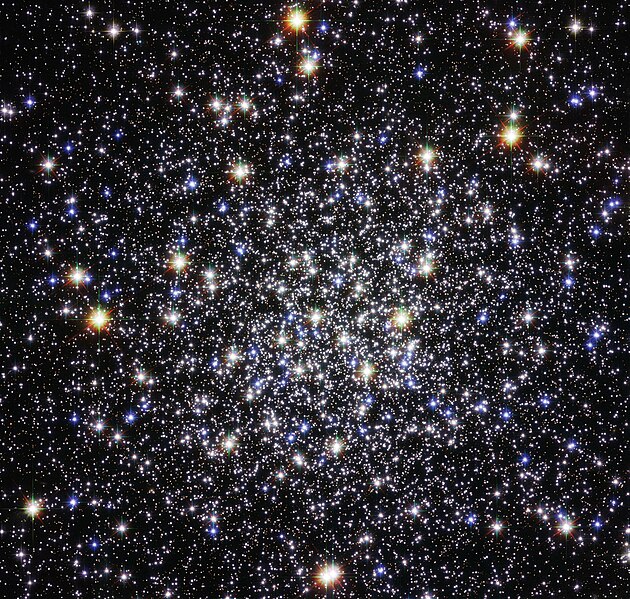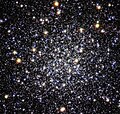پەڕگە:M12 Hubble.jpg

قەبارەی ئەم پێشبینینە: ٦٣٠ لە ٥٩٩ پیکسەڵ. ڕێزەلووشنەکانی تر: ٢٥٢ لە ٢٤٠ پیکسەڵ | ٥٠٥ لە ٤٨٠ پیکسەڵ | ٨٠٨ لە ٧٦٨ پیکسەڵ | ١٬٠٧٧ لە ١٬٠٢٤ پیکسەڵ | ٢٬١٥٤ لە ٢٬٠٤٨ پیکسەڵ | ٣٬٨٩٩ لە ٣٬٧٠٨ پیکسەڵ.
پەڕگەی سەرەکی (٣٬٨٩٩ × ٣٬٧٠٨ پیکسڵ، قەبارەی پەڕگە: ١٧٫٣٩ مێگابایت، جۆری ئێم ئای ئێم ئی: image/jpeg)
مێژووی پەڕگە
کرتە بکە لەسەر یەکێک لە ڕێکەوت/کاتەکان بۆ بینینی پەڕگەکە بەو شێوەی لەو کاتەدا بووە.
| ڕێکەوت/کات | ھێما | ئەندازە | بەکارھێنەر | تێبینی | |
|---|---|---|---|---|---|
| هەنووکە | ٠٤:٠٦، ١٦ی تشرینی دووەمی ٢٠١٧ |  | ٣٬٨٩٩ لە ٣٬٧٠٨ (١٧٫٣٩ مێگابایت) | Ras67 | higher quality |
| ١٦:٠٨، ٢٩ی ئازاری ٢٠١١ |  | ٣٬٨٩٩ لە ٣٬٧٠٨ (٧٫٢٦ مێگابایت) | Jmencisom | Enhanced color | |
| ٢٣:١١، ١ی ئابی ٢٠٠٨ |  | ٤٬٨٠٠ لە ٤٬٨٠٠ (٩٫٩٦ مێگابایت) | Friendlystar | {{Information |Description={{en|1=Messier object 12 core by Hubble Space Telescope, 3.18′ view}} |Source=en:WikiSky's snapshot tool - [http://server1.sky-map.org/snapshot?survey=astrophoto&img_id=all&angle=0.053&ra=16.787253&de=-1.943438&x_shift=0& |
بەکارھێنانی پەڕگە
ئەم پەڕەیە ئەم پەڕگەیە بەکار دەھێنێت:
بەکارھێنانی سەرانسەریی پەڕگە
ئەم ویکیانەی دیکەی خوارەوەش ئەم پەڕگە بەکاردێنن:
- بەکارھێنان لە af.wikipedia.org
- بەکارھێنان لە ar.wikipedia.org
- بەکارھێنان لە ast.wikipedia.org
- بەکارھێنان لە az.wikipedia.org
- بەکارھێنان لە be-tarask.wikipedia.org
- بەکارھێنان لە be.wikipedia.org
- بەکارھێنان لە bn.wikipedia.org
- بەکارھێنان لە ca.wikipedia.org
- بەکارھێنان لە ce.wikipedia.org
- بەکارھێنان لە cs.wikipedia.org
- بەکارھێنان لە de.wikipedia.org
- بەکارھێنان لە diq.wikipedia.org
- بەکارھێنان لە el.wikipedia.org
- بەکارھێنان لە en.wikipedia.org
- بەکارھێنان لە en.wikibooks.org
- بەکارھێنان لە eo.wikipedia.org
- بەکارھێنان لە es.wikipedia.org
- بەکارھێنان لە et.wikipedia.org
- بەکارھێنان لە eu.wikipedia.org
- بەکارھێنان لە fr.wikipedia.org
- بەکارھێنان لە fr.wikibooks.org
- بەکارھێنان لە gd.wikipedia.org
- بەکارھێنان لە he.wikipedia.org
- بەکارھێنان لە ia.wikipedia.org
- بەکارھێنان لە id.wikipedia.org
- بەکارھێنان لە ja.wikipedia.org
- بەکارھێنان لە ka.wikipedia.org
- بەکارھێنان لە kk.wikipedia.org
- بەکارھێنان لە ko.wikipedia.org
- بەکارھێنان لە ku.wikipedia.org
بینینی بەکارھێنانی گشتی زیاتری ئەم پەڕگەیە.

